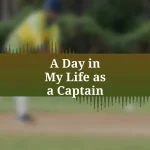Key takeaways:
- Effective communication fosters trust and enhances team dynamics, leading to improved performance.
- Collective achievements and celebrating individual successes strengthen team bonds and morale.
- Conflicts can promote growth and understanding when addressed openly and constructively.
Author: Evelyn Harper
Bio: Evelyn Harper is an award-winning author known for her evocative storytelling and rich character development. With a background in psychology, she weaves intricate narratives that explore the complexities of human relationships. Her debut novel, “Whispers in the Wind,” received critical acclaim and established her as a fresh voice in contemporary fiction. A graduate of the Iowa Writers’ Workshop, Evelyn resides in Portland, Oregon, where she continues to write and inspire aspiring authors through workshops and mentorship. When not immersed in her writing, she enjoys hiking the Pacific Northwest trails and sipping coffee at local cafes.
Understanding Team Dynamics
Understanding team dynamics is a fascinating journey that goes beyond just playing the game; it delves into the relationships and interactions that shape our experiences. I remember a match where our team was falling apart, tension palpable in the air. I couldn’t help but wonder: what makes a team truly cohesive? Is it just talent, or is there something deeper at play?
Reflecting on my experiences, I’ve learned that communication plays a pivotal role in fostering a strong team dynamic. There was a time when I hesitated to voice my concerns about a strategy, fearing judgment. But once I spoke up, it opened the floodgates for others to share their thoughts too. This conscious exchange transformed our approach, making us more versatile and united on the field.
Moreover, the emotional aspect of team dynamics cannot be understated. I’ve felt the thrill of shared victories and the weight of losses that linger long after the final whistle. How do we process these emotions together? It’s through building trust, showing empathy, and connecting on a human level that we can truly understand each other, not just as players, but as teammates.
Importance of Teamwork in Sports
Teamwork in sports is more than just cooperating on the field; it’s about building relationships that enhance performance. I vividly remember a particularly challenging tournament when our communication faltered. Instead of encouraging one another, we began to blame mistakes. It was a wake-up call that highlighted how vital it is for teammates to lift each other up, fostering a trusting environment that brings out the best in everyone.
In moments of pressure, the strength of a team’s bond is truly tested. During a crucial game, we found ourselves behind and the atmosphere was thick with anxiety. But when we rallied together, reminding each other of our strengths and capabilities, it turned everything around. Seeing my teammates believe in one another sparked a collective resilience that ultimately led us to victory. Isn’t it fascinating how the trust we build off the pitch translates into our performance on it?
Ultimately, success in sports hinges on collaboration and shared goals. There was a season when our team set specific objectives, and that unity infused us with a sense of purpose. We supported each other through highs and lows, celebrating every achievement. This experience solidified my belief that teamwork is not just a strategy; it’s an emotional investment we make in each other, driving both personal and collective growth. How could any player overlook the power of such camaraderie?
Challenges of Team Cohesion
One significant challenge of team cohesion is the emergence of personal conflicts. I faced this firsthand when two teammates had a disagreement that escalated during practice. Instead of focusing on the game, the tension hung in the air, and it became difficult for the rest of us to concentrate. This experience taught me how unresolved issues can silently undermine a team’s performance.
Another hurdle is differing levels of commitment among players. There were times when I noticed that not everyone was equally invested, which created frustration within the group. It’s disheartening to see your teammates not pushing their limits when you’re pouring your heart into every practice. Have you ever felt that disparity in energy? It can be a real test of patience and resolve.
Lastly, adapting to varying playing styles can pose a challenge. I can recall a season where merging my aggressive approach with a more conservative teammate’s style led to confusion on the field. Too often, we were out of sync, which prevented us from executing plays smoothly. This experience underscored the importance of open communication—after all, how can we perform cohesively if we don’t understand each other’s strengths and preferences?
Key Moments of Team Success
Key moments of team success often arise from collective achievements that resonate deeply among the players. I vividly recall a match where we all rallied around a teammate who was struggling with their performance. Instead of isolating him, we decided to lift his spirits by celebrating even the smallest contributions he made throughout the game. That sense of unity not only boosted his confidence but also brought us closer as a team, reminding me that our collective mindset can turn individual struggles into shared victories.
There was also an unforgettable match where we turned the tide from an impending defeat to a stunning win. With five wickets down and the odds stacked against us, we huddled and reminded ourselves of our strengths. Encouragement flowed freely as we communicated tactics on the spot, showcasing resilience that I hadn’t experienced before. Does that kind of synergy sound familiar to you? It was in that moment I realized how important it is for every player to buy into the team’s vision and support each other when the stakes are high.
Reflecting on these experiences, I find that moments of triumph often come from our ability to adapt and respond to challenges together. I remember a pivotal game where we successfully executed a new strategy after practicing it just once prior. The thrill of seeing our plans unfold on the field solidified my belief in the power of collaboration. How incredible is it to witness a team’s hard work transform into success right before your eyes? These moments create bonds that stretch beyond the pitch, reminding me that true success is about the journey we share as a team.
Lessons Learned from Team Interactions
The dynamics of team interactions have taught me that communication can make or break a game. I remember a practice session where we faced a fierce rival. We were all tense, and frustration hung in the air. But as we started openly discussing our individual fears and strategies, the mood shifted. It was like a veil lifted, and I realized that vulnerability among teammates fosters trust. How often do we think about the strength found in honest conversations?
One lesson that truly resonated with me was the significance of celebrating each other’s victories, no matter how small. During a friendly match, I had a teammate hit his first boundary. Instead of just a nod of acknowledgment, we all erupted in cheers. That small moment transformed his energy and confidence for the rest of the game. Have you ever experienced the ripple effect of positivity? In cricket, these interactions can lift a player’s performance, ultimately benefiting the team’s overall morale.
Through all these exchanges, I’ve learned that conflict can actually lead to growth. I faced a disagreement about our batting order that was quite heated. However, when we finally sat down to hash things out, we not only reached a compromise but also discovered each other’s strengths better. This experience showed me the importance of embracing diverse viewpoints. Isn’t it amazing how what seems like a stumbling block can become a stepping stone for deeper understanding and improved teamwork?



